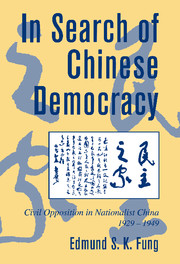Book contents
- Front Matter
- Contents
- Acknowledgments
- A Note on Romanization
- Abbreviations
- Introduction
- 1 The Dictatorial Regime
- 2 Setting the Opposition Agenda: The Issue of Human Rights, 1929–1931
- 3 The National Emergency, 1932–1936: Political and Intellectual Responses
- 4 In Defense of Democracy, 1933–1936
- 5 An Abortive Democratic Experiment: The People's Political Council, 1938–1945
- 6 Wartime Democratic Thought
- 7 The Third Force Movement: The Chinese Democratic League, 1941–1945
- 8 “Peace, Democracy, Unification, and Reconstruction,” 1946
- 9 The Last Stand of Chinese Liberalism
- Conclusion
- Selected Bibliography
- Glossary
- Index
8 - “Peace, Democracy, Unification, and Reconstruction,” 1946
Published online by Cambridge University Press: 22 September 2009
- Front Matter
- Contents
- Acknowledgments
- A Note on Romanization
- Abbreviations
- Introduction
- 1 The Dictatorial Regime
- 2 Setting the Opposition Agenda: The Issue of Human Rights, 1929–1931
- 3 The National Emergency, 1932–1936: Political and Intellectual Responses
- 4 In Defense of Democracy, 1933–1936
- 5 An Abortive Democratic Experiment: The People's Political Council, 1938–1945
- 6 Wartime Democratic Thought
- 7 The Third Force Movement: The Chinese Democratic League, 1941–1945
- 8 “Peace, Democracy, Unification, and Reconstruction,” 1946
- 9 The Last Stand of Chinese Liberalism
- Conclusion
- Selected Bibliography
- Glossary
- Index
Summary
In august 1945, the Chinese won the war but did not win the peace. National salvation was partially, and only partially, achieved. No sooner had the Japanese surrendered than the threat of a renewed civil war loomed large. Reflecting the mood of the intellectual community, civil opposition took on the slogan “peace, democracy, unification, and reconstruction.” The order of these words was significant. First, there must be peace – only then could there be democracy – then, democracy, and only then could there be unification, or national unity. And only with peace, democracy, and unity could there be reconstruction. This was similar to the CCP's slogan “peace, democracy, and unity,” portraying the government as an obstacle to peace. For its part, the government insisted on unity, or unification, prior to democracy, meaning that the Communists must give up their armed opposition first. As for the masses, after a devastating eight-year war, the last thing they wanted was civil war.
This chapter is largely a narrative. The facts are laid out here to add to the themes of this book. The Political Consultative Conference (PCC) and the subsequent peace efforts of the third force illustrate the theme of peace, democracy, unification, and reconstruction. The PCC, especially, sheds lights on the way in which civil opposition conducted itself as it attempted to translate its ideas into policies.
- Type
- Chapter
- Information
- In Search of Chinese DemocracyCivil Opposition in Nationalist China, 1929–1949, pp. 263 - 297Publisher: Cambridge University PressPrint publication year: 2000



